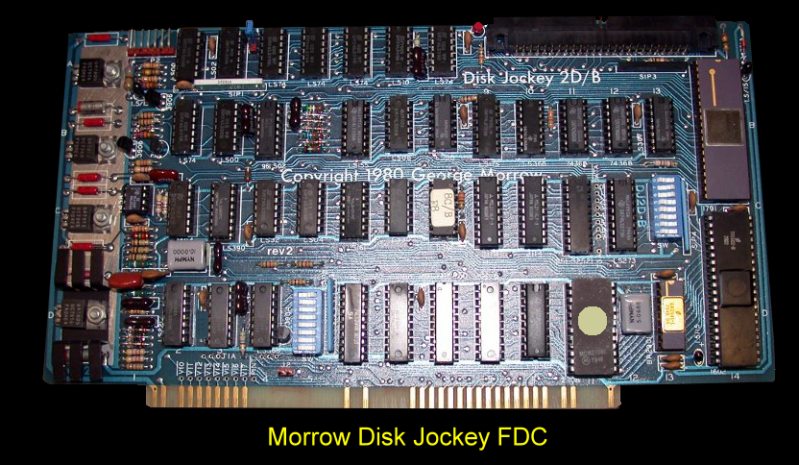
Morrow - Disk Jockey 2D Floppy
Disk Controller
This was one of Morrows most successful
boards. The board was normally sold as board + 8" Drive + cable + drive cabinet
+ software as the "Discus" system. The 2D was listed as Discus 2+2 (8"
double density double sided disks) giving 1.2Mg of storage per disk.

The Disk Jockey/Direct Memory Access
(DJDMA) Floppy Disk Controller was a single board for the S-100 bus. It
communicated with both 8 inch and 5 inch floppy disk drives. Up to eight drives
could be connected to the controller - with the limitation that no more than
four of each type could be accommodated. Special programmable bipolar LSI logic
made it possible to read and write media in almost any format, be it hard or
soft sectored disks. Normally the controller was used for soft-sectored IBM
compatible 8 inch media. However many used it for hard-sectored North Star
compatible 5 inch media.
The controller had its own Z-80 4MHz
microprocessor which was used to supervise data transfers between the disk drive
and the system memory without intervention of the main CPU. This relieves the
main CPU of time consuming processes which include head positioning, rotational
delays, and the usual byte-by-byte transfer of data from the diskette to main
memory. As a result, transfers are faster and more efficient. Moreover, the main
CPU has more time for data processing, and thus, supports more users and/or
tasks. The main advantage of the DJDMA controller over almost all the others was
its "glitch free" DMA channel. This advanced channel concept allowed the
controller to communicate with S-100 memory by "stealing" bus cycles from the
main CPU. This idea of an intelligent I/O channel was first implemented by IBM
on their famous 370 mainframes. For the first time, this powerful concept had
been implemented on the S-100 bus.
The DMA channel had the full 24-bits of
memory addressing as described in the proposed IEEE standard for the S-100 bus.
Also, a great deal of care was been taken in the design of the interface
circuitry so it conformed in every detail to this then new standard and still
allowed the controller to work well with existing systems designed before
the standardization effort was started. The controller is a temporary bus
master, meaning that it had the same access to memory as the CPU whenever it has
control. It also features priority logic which allows it to contend with up to
sixteen other "temporary" masters that may also want to "steal" bus
cycles from the main CPU, or the "permanent" master. The controller acts as
a temporary master (TMA). A temporary master may take control of the bus to
perform a DMA operation. This is possible because both the TMA and the CPU drive
control lines. The CPU, as permanent master, monitors signals from the TMA. When
the TMA wants control, it first asserts a HOLD/ signal to the CPU.
Assuming the TMA has priority, the CPU acknowledges this signal upon
completion of the present bus cycle by returning a processor hold acknowledge
(pHLDA) signal. Upon receipt of this signal, the TMA enables its control line
and asserts a control disable (CDSB) signal, disabling the CPU's control line.
The TMA then disables the CPU's data-out, address and status lines using DODSB/,
ADSB/ and SDSB/ signals. At that point the TMA has complete control to perform
its DMA operation. To return control to the CPU, the TMA first disables its own
data-out, address and status lines, then re-enables the CPU's control lines, and
simultaneously, its data-out, address and status lines. The TMA then releases
its control line and makes false the HOLD/ signal, thus returning f u11 control
to the CPU. So far, the process has been described as if only one temporary
master wanted control of the bus.
There can be up to 16 temporary masters
on the bus. When there is more than one temporary master, they use the four DMA
lines to decide who gets to assert HOLD. Any device requesting the bus places
its TMA priority level on the bus, and circuitry on the device decides if it has
the highest priority. The device with the highest priority (0F hex is highest)
asserts HOLD/. It removes its priority from the DMA lines when it receives pHLDA
from the permanent master. The features associated with the intelligent channel
on the controller make it exceptionally desirable in multi-tasking and
multi-user applications. In fact, many were tailored to enhance the performance
of Morrow Designs new, powerful DECISION I multiprocessing IEEE 696/S-100
machine. The DJDMA is an integral part of this advanced microcomputer system
which incorporates many of the concepts originally introduced by IBM in their
famous 370 series mainframes. The DJDMA can boot itself up on the bus and even
has a primitive serial port which is intended for diagnostic purposes or
possibly even integrating the controller into a larger S-100 system that has I/O
that the boot disk is not aware of. Under no circumstances can it be used as a
general purpose serial port to the system, however, since it is inactive during
disk activity.
The manual for this board can be
obtained here.
Morrow S-100 Boards
24K RAM
64K RAM
Disk Jockey FDC
Multi I/O
SuperRAM
SwitchBoard
Z80 Board
Hard Disk Controller
This page was last modified
on
01/08/2011


